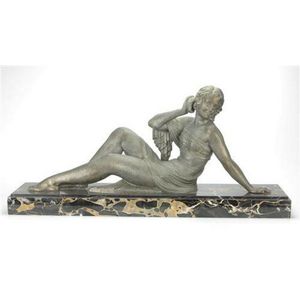French Art Deco Lady with Hound on Marble Platform
You must be a subscriber, and be logged in to view price and dealer details.
Subscribe Now to view actual auction price for this item
When you subscribe, you have the option of setting the currency in which to display prices to $Au, $US, $NZ or Stg.
- Art Deco Period - The Art Deco period was a cultural movement that emerged in the 1920s and 1930s, and was characterized by its emphasis on modernism, luxury, and elegance. The name "Art Deco" comes from the Exposition Internationale des Arts Décoratifs et Industriels Modernes, a large exhibition held in Paris in 1925 that showcased the latest trends in decorative arts.
Art Deco was a reaction against the ornate and elaborate styles of the previous era, and reflected a new modern sensibility. It was characterized by streamlined, geometric shapes, bright colours, and the use of new materials such as chrome, glass, and Bakelite. Art Deco designers sought to create a sense of luxury and sophistication, often incorporating expensive materials such as ivory, marble, and rare woods.
Art Deco had a significant impact on a wide range of artistic fields, including architecture, fashion, graphic design, and interior design. Some of the most iconic examples of Art Deco architecture include the Empire State Building in New York City, the Hoover Building in London, and the Palais de Chaillot in Paris.
The Art Deco period came to an end in the 1940s, as World War II and changing cultural trends led to a shift in artistic styles. However, Art Deco remains an important influence on design and art, and continues to be celebrated for its modernist sensibility and glamorous aesthetic. - Spelter - Spelter was the name given to an alloy of zinc and brass or copper used in the 19th century for statuary and lighting. It is a brittle bluish-white metal. It was used as a cheap replacement for bronze, but being brittle easily breaks and can't be repaired. When finished it can often be mistaken for bronze, but if discreet a scratch on the base displays shows a greyish colour, the metal is spelter, if a golden colour the metal is most likely bronze.
This item has been included into following indexes:
Visually similar items

An Art Deco bronze figure of a reclining female and dog mounted on a marble base. Female and dog are two separate pieces. Height 12 cm. (including Stand 19 cm).

A Nepalese gilt bronze figure of Sakyamuni 20th century or earlier, seated in earth touching mudra, cold gilt on the face, wood stand, 16.5 cm high (Buddha)

Spelter & marble figure, after Chiparus modelled as a young lady scantily clad, holding a shell to her ear. Signed 'D.H. Chiparus'. Condition good, minor age related wear. Length 74.5 cm

A rare bronze Lama, wearing a double Layered robe, inlaid with silver & copper, Tibet, 18th/19th century, pleated in part, the braiding on the edge with fine incised decoration, he is seated in the meditating pose on a double lotus pedestal, with short cro
